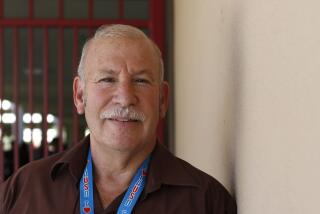L.A. Is Trying Out Some New Ideas
Around the country, some programs have shown promise in addressing the dropout problem. Here are a few that are being tried in Los Angeles:
First Things First
The idea: Building strong relationships between schools and students’ families is the cornerstone of this 10-year-old effort to improve student achievement at underperforming schools.Who uses it: Kansas City, Kan., was the first district to embrace the program; today, 13 districts nationwide use it. In the coming school year, Fremont High in South L.A. and Washington Preparatory in Athens will begin using it.
Main features: Students select themed “small learning communities” and remain with the same teachers and classmates throughout high school. Groups typically are no larger than 325 students. Each school staff member is a designated “family advocate” for up to 20 students. Students keep the same advocate throughout high school, and advocates meet with families at least once a month.
The evidence: Two outside assessments of First Things First in Kansas City found substantial improvements in such areas as attendance, reading and math. High school graduation rates, averaging 48% before the program was fully implemented, reached 81% in 2005.
Caveats: Kansas City officials are convinced their success is attributable in large part to a strong districtwide commitment to First Things First. District officials caution that it takes several years to see marked improvement. Also, First Things First adds staff and training costs, at least initially. Kansas City received grants, and L.A. Unified will receive almost $2.7 million from the Bill and Melinda Gates Foundation for it.
*
Knowledge Is Power Program, or KIPP
The Idea: Founded in 1994 by two alumni of Teach for America, a national corps of recent college graduates who pledge to teach for two years in public schools, KIPP focuses on opening fifth- through eighth-grade schools in low-income neighborhoods. The schools aim to bring students’ skills to grade level — and above — and get them on track to attend college.Who uses it: There are 47 KIPP schools in 15 states and Washington, D.C., including two charters in Los Angeles: KIPP Academy of Opportunity in South Los Angeles and KIPP LA Prep in Lincoln Heights.
Main features: Students and teachers spend more time in school (from 7:30 a.m. to 5 p.m. most days, and four hours every other Saturday). All are also required to attend a two-week summer session; students needing more help get extra tutoring. Principals take increased control of such things as budget and hiring. Standardized tests are given frequently to measure student achievement. KIPP programs work to build a sense of class spirit and teamwork. Slogans and spirited chants are recited, from the simple “Work hard, be nice,” to a more complicated one on how cells divide.
The evidence: Eighty percent of alumni nationwide attend college, according to the organization’s tracking surveys. The independent Education Policy Institute found KIPP students posted “large and significant” gains on standardized tests. The Academy of Opportunity’s seventh-grade scores climbed, over two years, from the 22nd to the 53rd percentile in reading and from the 27th to the 72nd percentile in math.
Caveats: Schools spend about $2,000 more per pupil each year than California provides, requiring private fundraising. Most are charters. Only highly motivated parents need apply.
*
Talent Development High School
The idea: Research has shown that students who are ill-prepared for high school-level work are at higher risk to drop out, so these schools place a special emphasis on ninth grade, with the goal of bringing students to grade level.Who uses it: At least some parts of the program are in use at 92 schools in 19 states and Washington, D.C. Francis Polytechnic High in Sun Valley uses several of Talent Development’s elements, and Jordan High in Watts will use the program in the fall.
Main features: Most schools group all ninth-graders into freshman academies. In 10th through 12th grades, schools are divided into small, career-themed groups. Students have the same teachers for the final three years. Students take fewer academic courses each semester, but classes are longer. Developed at Johns Hopkins University in Baltimore, Talent Development produces its own curriculum, with an emphasis on high-level language arts and math. Students get extra help as needed.
The evidence: In Philadelphia, where the program has been in place the longest, an independent evaluation found that the percentage of ninth-graders who passed the core curriculum rose from 43% to 56%. A follow-up report released last spring noted “substantial positive effects” on attendance, academic course credits earned, promotion to 10th grade and algebra pass rates.
Caveats: Talent Development adds costs for curriculum, staff development, smaller classes and other support for struggling students. Grants from the Bill and Melinda Gates Foundation and others have helped participating schools and districts pay for start-up and other costs.
— Jean Merl
More to Read
Start your day right
Sign up for Essential California for news, features and recommendations from the L.A. Times and beyond in your inbox six days a week.
You may occasionally receive promotional content from the Los Angeles Times.







